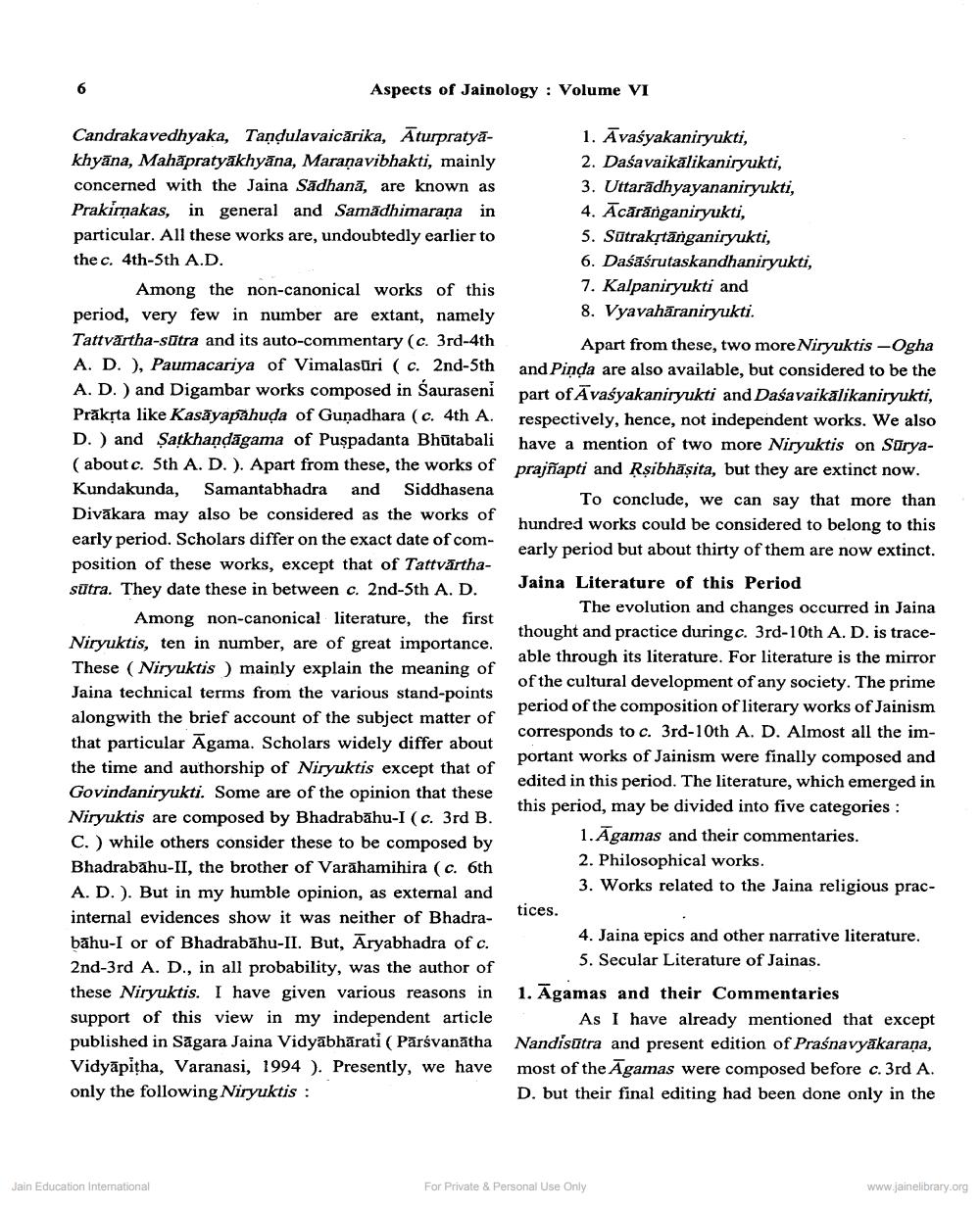________________
Aspects of Jainology : Volume VI
Candrakavedhyaka, Tandulavaicārika, Āturpratya
1. Āvaśyakaniryukti, khyāna, Mahāpratyākhyāna, Maranavibhakti, mainly
2. Daśavaikalikaniryukti, concerned with the Jaina Sādhanā, are known as
3. Uttarādhyayananiryukti, Prakirņakas, in general and Samadhimarana in
4. Ācārānganiryukti, particular. All these works are, undoubtedly earlier to
5. Sutrakītānganiryukti, the c. 4th-5th A.D.
6. Daśāśrutaskandhaniryukti, Among the non-canonical works of this
7. Kalpaniryukti and period, very few in number are extant, namely
8. Vyavahāraniryukti. Tattvārtha-sūtra and its auto-commentary (c. 3rd 4th
Apart from these, two more Niryuktis -Ogha A. D. ), Paumacariya of Vimalasuri (c. 2nd-5th and Pinda are also available, but considered to be the A. D.) and Digambar works composed in Sauraseni part ofĀvasyakaniryukti and Daśavaikalikaniryukti, Prakrta like Kasayapahuda of Gunadhara (c. 4th A. respectively, hence, not independent works. We also D. ) and Satkhandāgama of Puşpadanta Bhūtabali have a mention of two more Niryuktis on Sürya(about c. 5th A. D.). Apart from these, the works of prajñapti and Rşibhāṣita, but they are extinct now. Kundakunda, Samantabhadra and Siddhasena
To conclude, we can say that more than Divakara may also be considered as the works of
hundred works could be considered to belong to this early period. Scholars differ on the exact date of com
early period but about thirty of them are now extinct. position of these works, except that of Tattvārthasūtra. They date these in between c. 2nd-5th A. D.
Jaina Literature of this period
The evolution and changes occurred in Jaina Among non-canonical literature, the first
thought and practice duringc. 3rd-10th A. D. is traceNiryuktis, ten in number, are of great importance.
able through its literature. For literature is the mirror These ( Niryuktis ) mainly explain the meaning of
of the cultural development of any society. The prime Jaina technical terms from the various stand-points
period of the composition of literary works of Jainism alongwith the brief account of the subject matter of
corresponds to c. 3rd-10th A. D. Almost all the imthat particular Āgama. Scholars widely differ about
portant works of Jainism were finally composed and the time and authorship of Niryuktis except that of
edited in this period. The literature, which emerged in Govindaniryukti. Some are of the opinion that these
this period, may be divided into five categories : Niryuktis are composed by Bhadrabāhu-I (c. 3rd B.
1. Āgamas and their commentaries. C.) while others consider these to be composed by Bhadrabahu-II, the brother of Varahamihira (c. 6th
2. Philosophical works. A. D. ). But in my humble opinion, as external and
3. Works related to the Jaina religious pracinternal evidences show it was neither of Bhadra- the bāhu-I or of Bhadrabāhu-II. But, Aryabhadra of c.
4. Jaina epics and other narrative literature. 2nd-3rd A. D., in all probability, was the author of
5. Secular Literature of Jainas. these Niryuktis. I have given various reasons in 1. Agamas and their Commentaries support of this view in my independent article . As I have already mentioned that except published in Sagara Jaina Vidyābhārati (Pārsvanātha Nandisutra and present edition of Praśnavyākarana, Vidyāpitha, Varanasi, 1994). Presently, we have most of the Agamas were composed before c. 3rd A. only the following Niryuktis :
D. but their final editing had been done only in the
Jain Education International
For Private & Personal Use Only
www.jainelibrary.org




